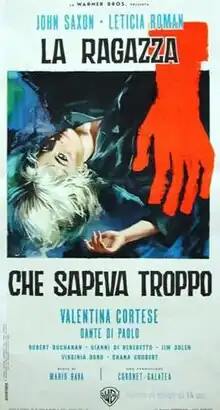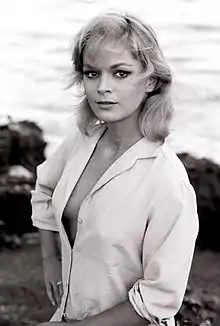The Girl Who Knew Too Much (1963 film)
The Girl Who Knew Too Much (Italian: La ragazza che sapeva troppo) is a 1963 Italian giallo film. Directed by Italian filmmaker Mario Bava, the film stars John Saxon as Dr. Marcello Bassi and Letícia Román as Nora Davis. The plot revolves around a young woman named Nora, who travels to Rome and witnesses a murder. The police and Dr. Bassi don't believe her since a corpse can't be found. Several more murders follow, tied to a decade-long string of killings of victims chosen in alphabetical order.
| The Girl Who Knew Too Much | |
|---|---|
 Italian film poster | |
| Directed by | Mario Bava |
| Screenplay by |
|
| Story by |
|
| Produced by | Massimo De Rita[1] |
| Starring | |
| Cinematography | Mario Bava[1] |
| Edited by | Mario Serandrei[1] |
| Music by | Roberto Nicolosi |
| Color process | Black and white |
Production companies |
|
| Distributed by | Warner Bros. (Italy)[2] |
Release date |
|
Running time | 86 minutes |
| Country | Italy[3] |
| Budget | 190 million Italian lire (Italy) |
| Box office | 80 million Italian lire (Italy) |
The Girl Who Knew Too Much is considered to be the first giallo film, a film genre with a mixture of thriller, sexploitation and horror conventions.[4] An alternative cut titled The Evil Eye was released in the UK and United States by American International Pictures; this version features a score by Les Baxter, deletes several scenes, and adds others which place a greater emphasis on comedy compared to the Italian release.
Plot

On vacation, Nora Davis visits her elderly ailing aunt in Rome. Nora's aunt is being treated by Dr. Marcello Bassi. Nora's aunt passes away on the first night of Nora's visit and she walks to the nearby hospital to notify Dr. Bassi. On the way, she is mugged and knocked out in Piazza di Spagna. When she wakes up, she sees the corpse of a woman lying near her; a bearded man pulls a knife out of the body. Nora reports this to the police in the hospital, who do not believe her after finding no evidence that a crime has been commited.
At a cemetery, Nora meets a close friend of her aunt's, Laura Torrani, who lives in Piazza di Spagna. Laura is going on a vacation and allows Nora to stay in her house. At Laura's, Nora comes across clippings of articles on the "Alphabet Killer", a serial killer whose victims have been alphabetically murdered according to their surnames. The killer has already murdered people whose last names begin with "A," "B," and "C". The last victim was Laura's sister, whom Nora had seen in a vision. This murder took place ten years ago. Nora receives a telephone call, in which an anonymous voice tells her that "'D' is for death," and informs her that she will be the next victim.
Nora receives help from Dr. Marcello, who takes her on a trip to various tourist sites to calm her down as they become more romantically interested in each other. When they return to the Craven house, she receives a call from someone who orders her to go to a particular address. Nora goes there, and she is guided to a vacant room. With Dr. Marcello, she discovers that the voice that guided her is tape recorded, and it warns Nora to leave Rome before it is too late. The vacant room is leased to investigative reporter Landini. After several unsuccessful attempts to locate him, Nora and Marcello go to the beach to relax. Upon their return to the Craven house, they find Landini, who has been told that they were inquiring about him. Landini has secretly been following them since he spotted Nora in the square.
He wrote about the murder story when it first broke but believes the police would catch the wrong person if he reported the details of the crime. His refusal to publish a report of the murder has put him in financial need. Nora decides to help Landini, but, as they tour Rome, they find no clues. Nora visits Landini's apartment the next day, finding clues that lead her to think that he is the murderer. Landini later appears to have committed suicide. Laura returns to Rome from her vacation while Nora and Marcello plan to go to America the following morning. From reading the newspaper, Nora learns that the body of the young woman was found. After identifying the victim's corpse at the morgue, Nora believes that she has witnessed the murder. Alone in the house that night, Nora notices the study door is open. On entering, she sees a man rising from his chair. He is the man who was standing over the body. The man walks towards Nora but collapses to the floor, a knife in his back. Nora is then confronted by Laura who, enraged, confesses to the killings. It turns out that she stabbed that man, her husband, because of his attempts to turn her over to the police. Her desire to steal her sister's money apparently compelled her to murder. Laura attempts to attack Nora but is shot dead by her husband. He was actually disposing of the body for his wife the night Nora saw him. Nora then leaves Italy, happily reunited with Marcello.
Cast

- Letícia Román as Nora Davis (Nora Drowson in The Evil Eye)
- John Saxon as Dr. Marcello Bassi
- Valentina Cortese as Laura Craven-Toranni
- Dante DiPaolo as Andrea Landini
- Titti Tomaino as the Inspector
- Luigi Bonos as the Hotel Clerk
- Milo Quesada as De Vico
- Walter Williams (as Robert Buchanan)[5] as Dr. Alessi
- Marta Melocco as the murder victim
Production
Prior to working on The Girl Who Knew Too Much, Bava had taken a six-month break after filming the last of the special effects shots for his previous film Erik the Conqueror.[6] Bava spent this extended period reading mystery and horror magazines.[6] He pondered retiring from directing and thought he might only return to work on special effects for film.[7] Bava was convinced to return to directing by Samuel Arkoff and Jim Nicholson, who had begun co-producing Italian films for release in the United States.[8] The Girl Who Knew Too Much was the first film in this venture for Arkoff and Nicholson's company American International Pictures (AIP).[7] The film was produced by Galatea Film, which also produced Bava's earlier film Black Sunday, and Coronet films. The film benefited from AIP as a deal was set between the company and Galatea to have confirmed distribution overseas.[9]
The opening credits credit Sergio Corbucci (credited as "Enzo Corbucci"),[10] Ennio de Concini and Eliana de Sabata and the writers of the film, while crediting Mario Bava, Mino Guerrini and Franco Prosperi as collaborators.[1] Italian screenwriter Luigi Cozzi has said that the original script was more of a romantic comedy but the film became more of a thriller as it went into production.[11]
Letícia Román was cast in The Girl Who Knew Too Much; her first leading role.[12] Román knew actor John Saxon prior to production on the film.[13] Saxon has stated that he was invited by Roman to work on the film by asking if he would be interested in an art film in Rome.[13] Saxon agreed, but on receiving the script he found that he misunderstood her as she said horror film instead.[13][14][15] Dante DiPaolo stated that Bava initially thought DiPaolo was too young for his role in the film, but after seeing his screen test he felt DiPaolo understood his part well and cast him in this film and later again in Blood and Black Lace.[16] Film began with tentative title Incubo infuori programma with the planned English title being Incubus.[9]
The Girl Who Knew Too Much began shooting on May 2, 1962.[17] Director Mario Bava thought the plot was silly, and focused more on the technical aspects of the film.[18] This included shooting the film in black and white, Bava's last film shot in this style.[19] Bava had made earlier films in color, but films in the horror and thriller genre made in Italy were generally shot in black and white in this period.[20] Location shooting in Rome took place at various locations including the Leonardo da Vinci–Fiumicino Airport and the Trinità dei Monti.[21][22] Some set pieces were borrowed from other Italian films, such as the painting in Nora's aunt's house, which is from Divorce Italian Style.[23]
Saxon stated that he had initially gotten along with Bava during production.[24] Later Saxon would be practicing judo on the beach which would upset Bava who felt as if Saxon was showing off.[25] Saxon stated that later in a conversation with a producer for the film, that the producer said that Román convinced Saxon to enter the film as she said Saxon was in love with her.[26] Saxon felt that Bava was perhaps initially annoyed at him as he felt his action might have interpreted from Bava as trying to usurp attention from Román.[26] Filming finished in July 14, 1962.[17][9] Bava biographer Tim Lucas said that some re-shoots were apparently done towards the end of 1962.[17] Bava completed the film at a cost of 190 million Italian lire.[9]
The theme song of the film is sung by Adriano Celentano.[27] The film's score was by Roberto Nicolosi,[1] who had previously worked with Bava on Black Sunday (1960) and Erik the Conqueror (1961).[28][29]
Release
The Girl Who Knew Too Much was first released on February 10, 1963 in Cagliari.[30][9] The film grossed less than $27,000 on its opening and only weekend and failed to cover its own production cost.[31] The film was the least commercially successful picture in Bava's directorial career.[31] The giallo films were not popular among the Italian film audiences on its initial theatrical release as the genre never gained popularity in its home country until the release of Dario Argento's The Bird with the Crystal Plumage (1970) and The Cat o' Nine Tails (1971).[32] It grossed a total of 80 million Italian lire in Italy.[33]
The Girl Who Knew Too Much was released by American International Pictures in the United States on May 6, 1964, where it was shown on a double bill with Bava's Black Sabbath; this release of the film retitled it as The Evil Eye.[34][35] Alterations between the two versions include the deletion of several scenes, including all references to marijuana, the addition of more comical scenes, and Roberto Nicolosi's jazz score being replaced with one performed by Les Baxter.[36][19] The two versions also have different endings.[37] When Bava's films were being released on DVD and Blu-ray, the Evil Eye edit of the film became more difficult to find as Bava's original Italian version of the film was used. This led to audiences knowing the film under its translated Italian title, The Girl Who Knew Too Much.[38]
Reception
In a contemporary review, the Monthly Film Bulletin described the film as "a tolerably silly but quite enjoyable thriller". The reviewer praised the camerawork and acting by Valentina Cortese, whom he compared to Joan Crawford.[39] The reviewer noted the plot, stating that "Bava, always a better cameraman than director hasn't Riccardo Freda's ability to make a merit of cliches, and often seems rather unhappy with his complicated plot, which is packed to the brim with red herrings, lurking shadows and sinister happenings known to thrillerdom."[39]
Director Mario Bava did not look back positively on the film, claiming that he "thought [the film] was too preposterous. Perhaps it could have worked with James Stewart and Kim Novak, whereas I had... oh, well, I can't even remember their names."[40] The film has received a score of 71% on review aggregation website Rotten Tomatoes, with seven reviews posted, which note the stylish look to the film, but negatively point out its story.[41] Sight & Sound stated that "Although certainly pioneering, The Girl Who Knew Too Much is a low-key, modest film. It would be Bava's subsequent production, the violent, striking Blood and Black Lace, that would announce the genre's arrival in bold primary colours."[42]
References
Footnotes
- The Girl Who Knew Too Much (booklet). Arrow Films. 2014. p. 3. FCD1023.
- Vitali 2016, p. 36.
- Paul 2005, p. 106.
- Gelder 2000, p. 330.
- Lucas 2013, p. 341.
- Lucas 2014, 0:49:45.
- Lucas 2014, 0:50:05.
- Lucas 2014, 0:50:18.
- Curti 2022, p. 73.
- Howarth 2014, p. 47.
- Cozzi, Luigi. All About the girl (Blu ray (Disc 1)) (in Italian). Arrow Films. Event occurs at 0:00:50. FCD1023.
- Lucas 2014, 0:34:56.
- Lucas 2014, 0:06:20.
- John Saxon Interview (Blu ray (Disc 1)). Arrow Films. 2014. Event occurs at 0:01:30. FCD1023.
- John Saxon Interview (Blu ray (Disc 1)). Arrow Films. 2014. Event occurs at 0:02:01. FCD1023.
- Lucas 2014, 0:59:10.
- Lucas 2014, 0:26:58.
- Shipka 2011, p. 106.
- Jones.
- Lucas 2014, 0:47:02.
- Lucas 2014, 0:02:45.
- Lucas 2014, 0:09:05.
- Lucas 2014, 0:08:00.
- John Saxon Interview (Blu ray (Disc 1)). Arrow Films. 2014. Event occurs at 0:04:30. FCD1023.
- John Saxon Interview (Blu ray (Disc 1)). Arrow Films. 2014. Event occurs at 0:04:59. FCD1023.
- John Saxon Interview (Blu ray (Disc 1)). Arrow Films. 2014. Event occurs at 0:05:15. FCD1023.
- Lucas 2014, 0:00:45.
- "Roberto Nicolosi". AllMovie. Retrieved February 23, 2016.
- "Mario Bava filmography". AllMovie. Retrieved February 23, 2016.
- Lucas 2014, 0:00:21.
- Lucas 2014, 0:18:22.
- Brizio-Skov 2011, p. 64.
- Curti 2022, p. 77.
- Curti 2015, p. 79.
- Heffernan 2004, p. 151.
- Boyd & Palmer 2006, p. 200.
- Luther-Smith 1999, p. 45.
- Howarth 2015, p. 16.
- "Ragazza che sapeva troppo, La". Monthly Film Bulletin. London. 32 (372): 58. 1965. ISSN 0027-0407.
- Boyd & Palmer 2006, p. 201.
- "La Ragazza che sapeva troppo (The Girl Who Knew Too Much) (The Evil Eye) (1962)". Rotten Tomatoes. Retrieved 15 January 2019.
- Blackford, James (February 2015). "The Girl Who Knew Too Much". Sight & Sound. Vol. 25, no. 2.
Sources
- Boyd, David; Palmer, R. Barton (2006). After Hitchcock: Influence, Imitation, and Intertextuality. University of Texas Press. ISBN 0-292-71338-X.
- Brizio-Skov, Flavia (2011). Popular Italian Cinema: Culture and Politics in a Postwar Society. I.B.Tauris. ISBN 978-1848855724.
- Curti, Roberto (2015). Italian Gothic Horror Films, 1957-1969. McFarland. ISBN 978-1476619897.
- Curti, Roberto (2022). Italian Giallo in Film and Television. McFarland. ISBN 978-1-4766-8248-8.
- Gelder, Ken (2000). The Horror Reader. Routledge. ISBN 0-415-21356-8.
- Heffernan, Kevin (2004). Ghouls, Gimmicks, and Gold: Horror Films and the American Movie Business, 1953–1968. Duke University Press. ISBN 0822385554.
- Howarth, Troy (2014). The Haunted World of Mario Bava. Midnight Marquee Press, Inc. ISBN 978-1-936168-45-3.
- Howarth, Troy (2015). So Deadly, So Perverse: 50 Years of Italian Giallo Films. Vol. 1. Midnight Marquee Press. ISBN 978-1936168507.
- Jones, J.R. "The Girl Who Knew Too Much". Chicago Reader. Archived from the original on May 4, 2004. Retrieved November 22, 2022.
- Lucas, Tim (2014). Audio commentary with Tim Lucas (Blu ray). Arrow Films. FCD1023.
- Lucas, Tim (2013). Mario Bava: All the Colors of the Dark. Video Watchdog. ISBN 978-0-9633756-1-2.
- Luther-Smith, Adrian (1999). Blood & Black Lace. Stray Cat Publishing. ISBN 0-9533261-1-X.
- Paul, Louis (2005). Italian Horror Film Directors. McFarland. ISBN 978-0-7864-8749-3.
- Shipka, Danny (2011). Perverse Titillation: The Exploitation Cinema of Italy, Spain and France, 1960-1980. McFarland. ISBN 978-0786448883.
- Vitali, Valentina (2016). Capital and popular cinema: The dollars are coming!. Oxford University Press. ISBN 978-0719099656.